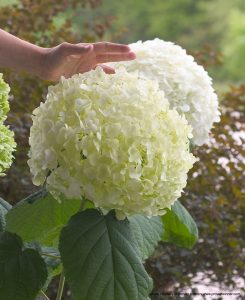How to Prune Your Hydrangeas
This week, in Cincinnati Gardening Made Simple, we answer, “How to Prune Your Hydrangeas?”
The good news, they typically do not require regular pruning. Most hydrangea will require nothing more than deadheading and dead wooding as needed by the plant.
Choosing Your Hydrangea
Make sure to choose a hydrangea that fits the space with its natural growing size. But once you have chosen your plant, pruning hydrangeas will depend on the needs of that particular variety.
HYDRANGEA ARBORESCENS
- Example of HYDRANGEA ARBORESCENS: ANNABELLE,’ ‘BELLA ANNA,’ ‘INCREDIBALL’ AND ‘STERILE’
- Blooms: They are June through August bloomers and bloom on new wood. The flowers are produced on the tips of the current season’s growth.
- Pruning Hydrangeas: At the beginning of spring, you cut back to 12 inches above the ground if revitalization is needed. As needed, the deadhead spent flowers just below the flower head.
- Prefers: They prefer partial sun to partial shade.
HYDRANGEA PANICULATA
- Example of Hydrangea Paniculta: ‘GRANDIFLORA,’ ‘PEEGEE,’ ‘VANILLA STRAWBERRY,’ ‘TARDIVA,’ ‘PINKY WINKY,’ ‘LIMELIGHT.’ ‘QUICK FIRE,’ ‘BOBO,’ AND ‘UNIQUE’)
- Blooms: They typically bloom mid-summer into September.
- Prune: In late fall to early spring, pruning can occur. If desired, cut back close to the ground. You want to deadhead spent flowers by removing just below the flower. Late in the season, during heaving rain and snow, be cautious of leaving spent flowers that can cause breakage.
- Prefers: It prefers full sun to partial shade.
HYDRANGEA macrophylla & SERRATA
- Examples of HYDRANGEA macrophylla & SERRATA: EX.‘NIKKO BLUE,’ ‘BLOOMSTRUCK,’ ‘SILVER VARIEGATED,’ ‘ENDLESS SUMMER,’ ‘ZEBRA,’ ‘TUFF STUFF’ AND ‘PREZIOSA.’
- Blooms: This type blooms on old wood. However, the newer selections bloom on both old & new wood. It typically blooms early to mid-summer bloomers.
- Prune Hydrangeas: During the season as needed, you want to deadhead spent flowers. By early July, the stem pruning should be completed allowing next year’s flower buds to set on the current growth. Macrophylla is known for inconsistent flowering due to winter damage.
- The following year, the plant often regrows with excellent foliage and limited flowers. In the spring, you should cut back dead stems to healthy buds if there is dieback. In many cases, by removing the stems at a ground level, new growth will appear from the roots.
- WINTER PROTECTION FOR macrophylla selections: You want to provide winter protection for the stems of your hydrangea. By building a small cage around the plant with chicken wire, you can protect the plant. In late fall, fill it with finely ground leaves and straw. In March, remove the cage and mulch.
- Note: As a result of a late freeze during the spring, it can cause damage to the flower buds that have successfully overwintered.
NEW MACROPHYLLA SELECTIONS
Example of NEW MACROPHYLLA SELECTIONS: ‘ALL SUMMER BEAUTY,’ ‘ENDLESS SUMMER,’ ‘BIG DADDY,’
- Prune Hydrangeas: It doesn’t matter if you prune at the wrong time or if it dies in winter. You’ll still get summer flowers. Earlier the following season, stems from the previous year will flower. If complete dieback occurs, it will take longer in the season to flower. As needed, deadhead and have any stem pruning (if required) finished by early July. Anytime during the year, deadheading can take place.
- Prefers: Partial sun to partial shade.
HYDRANGEA QUERN FOLIA
- Examples of HYDRANGEA QUERN FOLIA : ‘SNOW QUEEN,’ ‘PEE WEE,’ ‘ALICE’
- Blooms: Blooms on old wood. In late May through July, the Oakleaf hydrangeas typically flower. But, the flowers persist all season long.
- Pruning/Deadheading: When the flowers are no longer attractive, deadhead the spent flowers just below the bloom. By early July, if needed, have stem pruning as the flowers produced on the previous year’s growth. If constructive pruning is needed, prune after flowering.
- Due to the coarseness of the plant, early in the plant’s life, prune to encourage proper framework. After that, worry about pruning times for flowering. If your plant gets leggy and requires severe pruning, it will respond nicely to a significant cutback in the spring.
HYDRANGEA ANOMLA / PETIOLARIS
- Examples OF HYDRANGEA ANOMLA / PETIOLARIS :‘CLIMBING HYDRANGEA’
- Blooms: Blooms on old wood. This vining Hydrangea is a beautiful flowering woody vine that attaches itself to grow on trellises and fences. It is typically planted as a groundcover or pruned as a shrub. It can be slow to establish and to begin flowering. The slightly fragrant lace-cap flowers appear in the previous year’s growth in late June or early July.
- Prune Hydrangeas: After flowering, you want to prune. Early spring pruning would include removing dead wood, damaged branches, or light constructive pruning. Also, similar to the Oakleaf hydrangeas, any major pruning will result in fewer flowers the following season.
- Prefers: Partial sun or shade
Successful Pruning Basics for Hydrangeas
Pruning hydrangeas for flower production can be a series of trials and errors. If unsure, follow the basics by removing the spent flowers only as needed and prune any dead wood in the spring.
Have question? Ask the Experts!
Looking for a new plant? Take a look at the Plant Library!